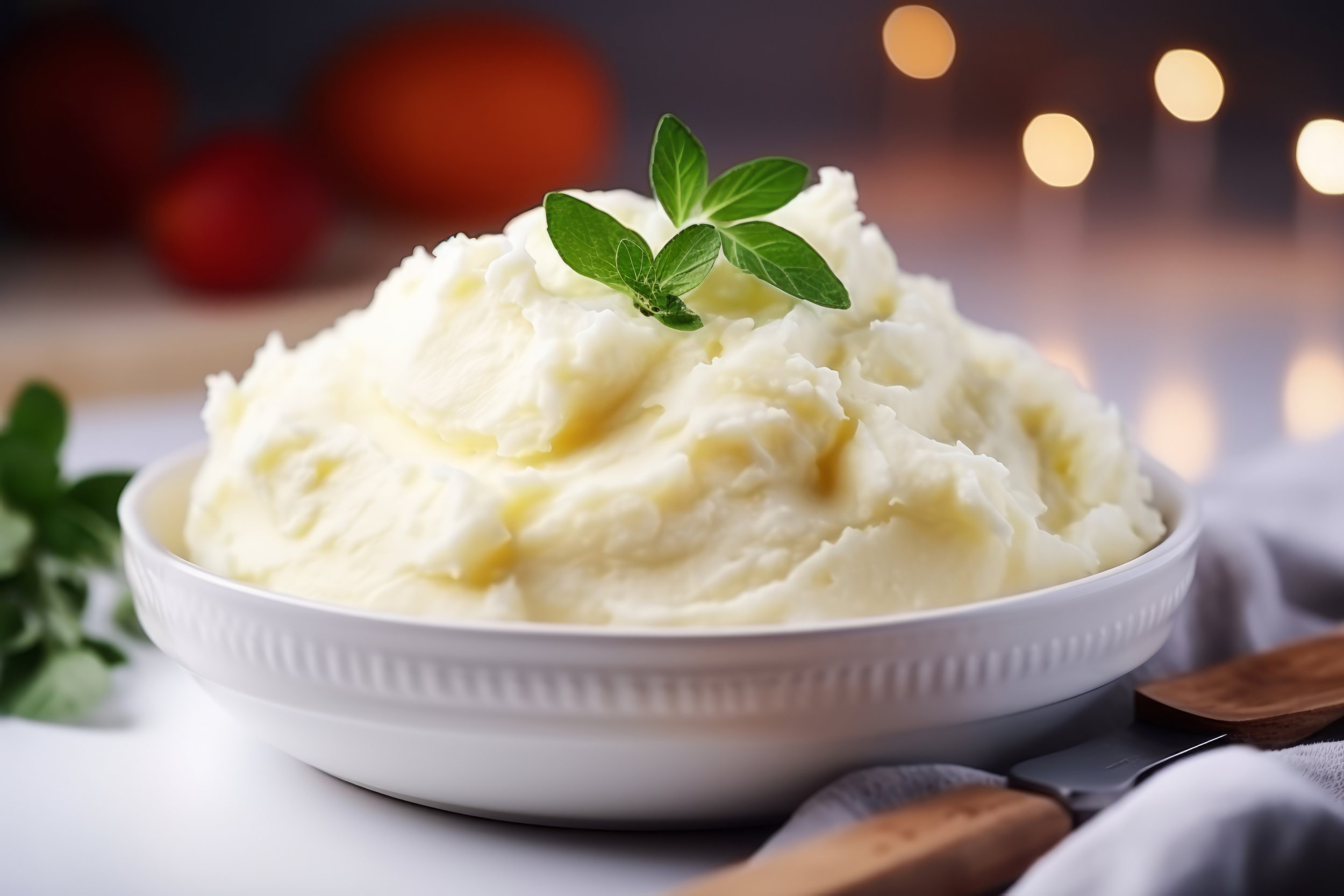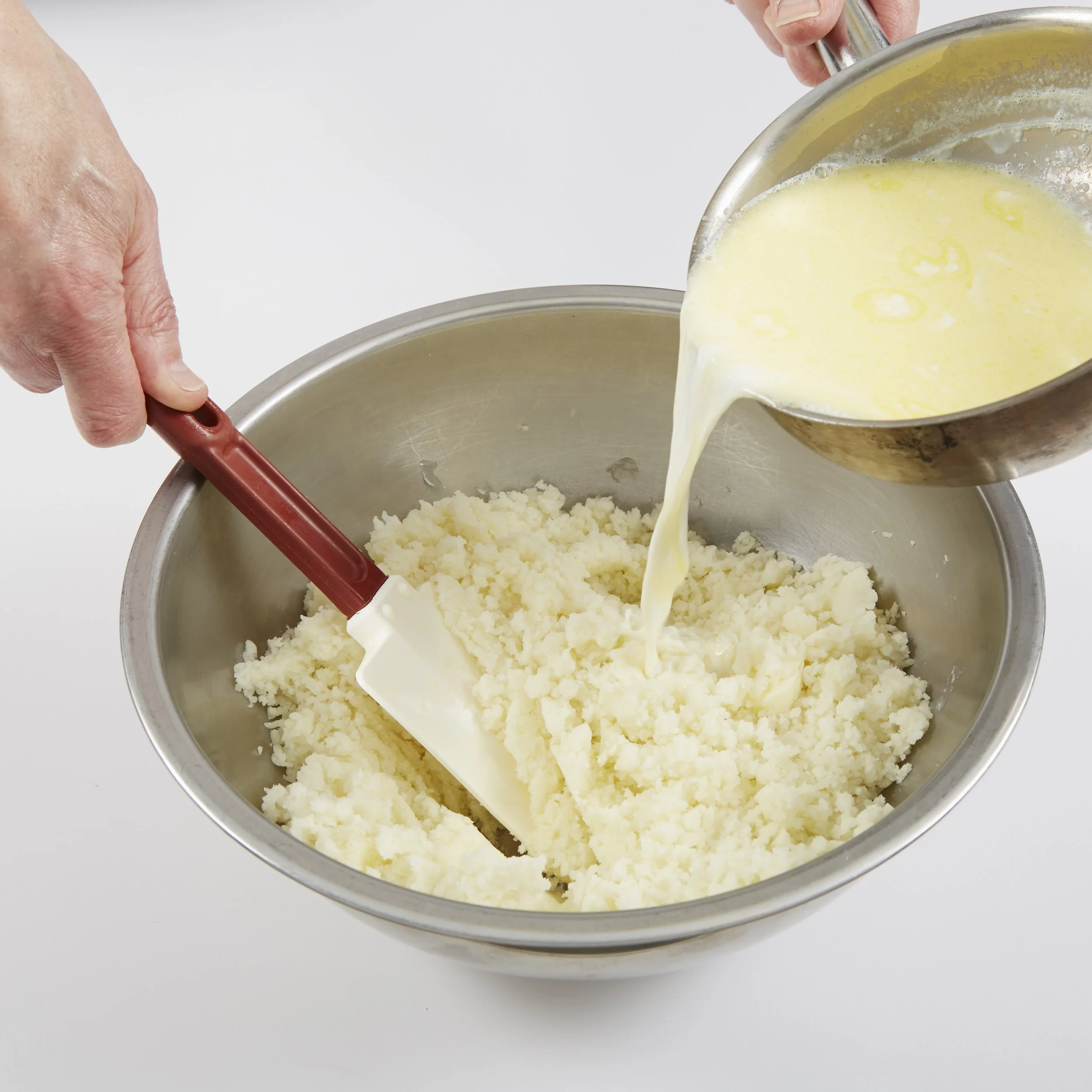puréed Potatoes
Whether you call them mashed, whipped, or pommes purée, this classic comfort food is easy to prepare once you know the basics. Requiring only a few additional ingredients, butter, cream, and seasoning, this dish is a great accompaniment for roasts, stews, and grilled steaks, chicken, or fish.
There are endless variations to this basic recipe, including additions like cheese, garlic, herbs, and spices. Potato pureé is also the foundation for Duchesse and Twice-Baked Potatoes.
Best Choice
The best type of potato to use for potato purée is a Russet. Yukon Gold also works well. New potatoes, like red skin or fingerling varieties, have a higher moisture content and are lower in starch, so they don’t break down as easily and are not ideal for pureeing.
Variations
This technique is also suitable for other types of root and tuber vegetables, such as sweet potatoes, rutabagas, turnips, celery root, parsnips, and carrots.
A combination of potatoes with other roots, for example, celery root or parsnips, is a tasty variation. Carrots and rutabagas are a great combination, too.
Avoid Food Processors and Blenders
Opt for a Food Mill or Potato Ricer, and Not a Blender, for Best Potato Purée Results
When preparing puréed potatoes, using a blender or food processor is tempting to save time. But if you’ve ever pureed potatoes this way, you know that you will end up with a gummy paste. This is because potatoes contain a high amount of starch and the high-speed blade of a food processor tears apart the starch molecules. Instead of light and fluffy potatoes, you are left with a gooey mess.
While it is extra work to puree potatoes by hand, it is well worth the time and effort. Opt for a food mill or a potato ricer to puree them. In a pinch, you can also use a grater.
Root vegetables, including carrots, celery roots, turnips, and rutabaga, can be pureed in a food processor because their structure is less starchy.
Prepping the Potatoes
Potatoes cooked whole with the skin on will result in more potato taste because when peeled and diced, the water dilutes their flavor. Steaming the potatoes, rather than submerging them in water, will also result in more flavor.
Start Potatoes in Cold Water
Starting potatoes in cold water results in a more even cooking process. Potatoes should be simmered and never boiled because aggressive cooking softens the vegetable starches, causing them to break down and disintegrate before they are fully cooked. Avoid adding salt to the water when cooking because it displaces calcium in vegetables, also causing them to disintegrate. Unlike most vegetables that are cooked and cooled by shocking in water, potatoes and tubers are not because this would make them soggy.
Drain Immediately
Check for tenderness with a fork or skewer. When they are done, the texture will gently give when pierced to the center. Drain immediately with a colander or strainer. Place them back in the pot and gently dry them for a few minutes over low heat.
Pureeing Tips
Potatoes puree best when they are warm. Therefore, have your other ingredients prepped when the potatoes have finished cooking. Once pureed, you can finish the potatoes by hand in a mixing bowl with a whisk or place them in a standing mixer with a whip attachment.
Ingredients and Ratios
A good ratio for pureed potatoes is for every one lb. (450 g) of potatoes, use four oz. (120 ml of cream or milk, and two oz. (60 g) of butter. You can use milk, cream, or a combination. The cream will give it a richer mouthfeel. The butter can be softened or melted.
Vegan Options
This recipe can be easily adapted for vegan diets by replacing the milk with plant-based milk, such as coconut or oat milk. Substitute a plant-based fat, for example, olive oil, or use a plant-based butter.
Equipment
Pot for the potatoes
Pan for the cream
Colander or strainer
Vegetable peeler
Potato ricer or food mill
Mixing Bowl and Whisk (or a standing mixer with a whip attachment)
Ingredients and Quantities
Potatoes, 1 lb./450 g
Cream/Milk 4 oz./120 ml
Butter 2 oz./60 ml
Salt and Pepper To Taste
Step 1 - Prep Ingredients
Scrub potatoes, remove eyes, sprouts, and green spots; peel if desired
Prep whole or cut (skin-on or off) into large dice 1 inch (3 cm)
Submerge in cold water to prevent discoloration
Measure the cream or milk and place it in a small pan for heating
Bring the butter to room temperature
Step 2 - Cook the Potatoes
Place the potatoes in a pot and add cold water.
Bring the water to a simmer and gently cook them until they are tender but not overcooked.
Test with a fork or a skewer.
Drain through a colander or strainer and place back into the pot.
Gently heat them to allow excess water to evaporate.
Step 3 - Puree and Mix with Cream and Butter
If the potatoes were cooked in their skin, peel them first.
Place in a food mill or a potato ricer and process them into a mixing bowl.
Add the cream and butter and blend together to a smooth consistency.
Adjust with salt and pepper.
Variations
Root vegetables can be substituted in the same quantity. A food processor will achieve the best results for root vegetables, including carrots, celery root, and rutabaga.
Potato and Celery Root Puree
Substitute 8 oz. (225 g) of celery root for 8 oz. (225 g) of the potatoes. Be sure to cook them separately, as their cooking time will be different from that of potatoes. You will need to puree the celery root in a food processor.
Potato and Parsnip Puree
Substitute 8 oz. (225 g) of parsnips for 8 oz. (225 g) of the potatoes. Be sure to cook them separately, as their cooking time will be different from that of potatoes. You will need to puree the celery root in a food processor.
Carrot and Rutabaga Puree
Substitute 12 oz. (340 g) of carrots and 4 oz (120 g) of rutabaga for the potatoes. Proceed with the recipe as written.
Additions and Substitutions
Pump up your potatoes with any of the following garnishes:
Bacon
Brown butter
Cheddar, Parmesan, or Mascarpone cheese
Olive Oil
Sour Cream
Garlic
Chives, parsley, or rosemary




